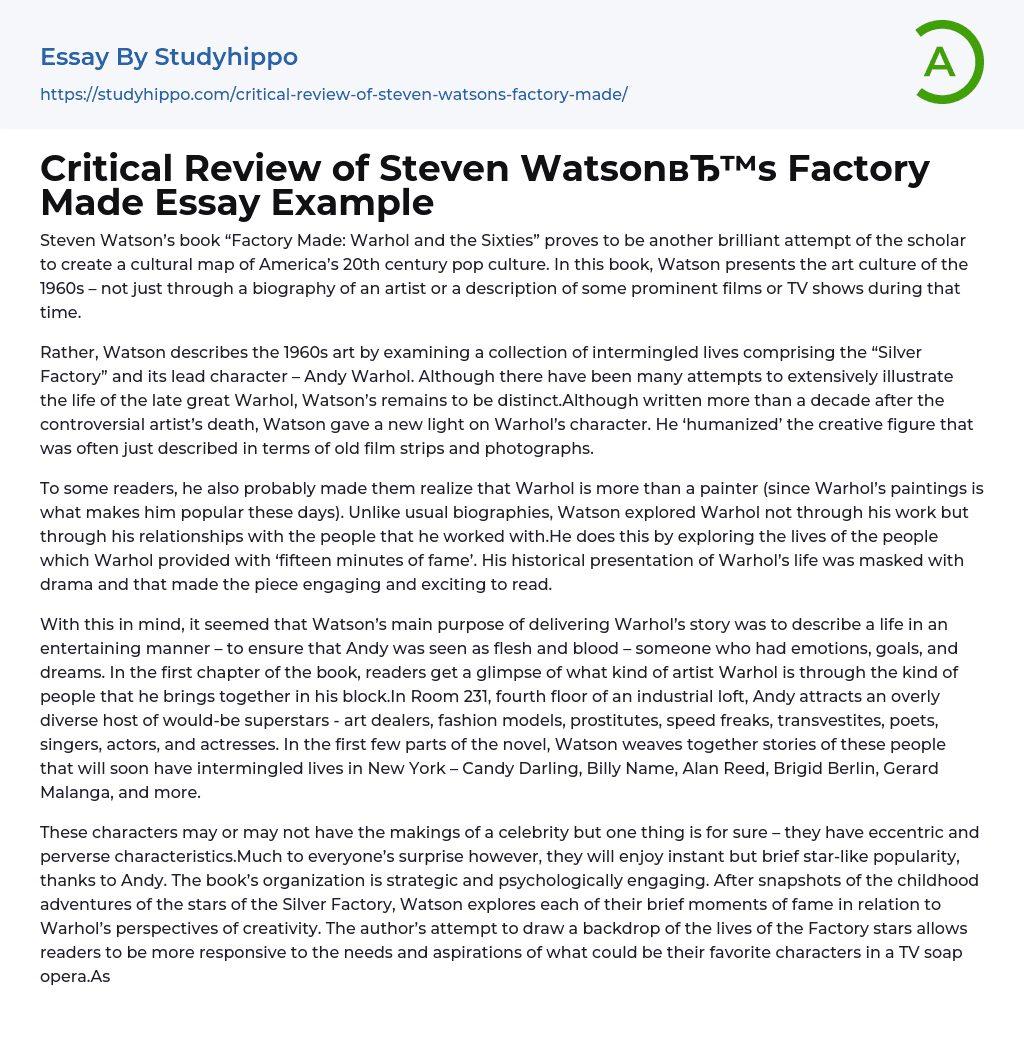Steven Watson’s book “Factory Made: Warhol and the Sixties” is a brilliant attempt to create a cultural map of America’s 20th century pop culture. Instead of focusing solely on a biography of an artist or a description of prominent films and TV shows from the 1960s, Watson examines a collection of intermingled lives centered around the “Silver Factory” and its lead character, Andy Warhol. Despite other extensive biographical works on Warhol, Watson's book stands out as distinct. Published more than a decade after Warhol's death, Watson sheds new light on the artist's character.
In the text, the author highlights how Warhol was able to humanize the creative figure typically depicted through old film strips and photographs. This depiction helps readers realize that Warhol's influence extends beyond his paintings, which have made him so popular today. Rather than
...focusing on Warhol's work, Watson explores his relationships with the individuals he provided with their "fifteen minutes of fame." This unique approach provides a historical presentation of Warhol's life while maintaining a sense of drama and engagement for the reader.
The main purpose of Watson's delivery of Warhol's story is to depict an entertaining portrayal of his life, ensuring that Andy is seen as a real person with emotions, goals, and dreams. In the first chapter, readers catch a glimpse of Warhol's artistic nature through the diverse mix of people he attracts in his loft on the fourth floor of an industrial building. Among the individuals gathered in Room 231 are art dealers, fashion models, prostitutes, speed freaks, transvestites, poets, singers, actors, and actresses. Through the stories intertwined in the novel, Watson introduces these characters such as Cand
Darling, Billy Name, Alan Reed, Brigid Berlin, Gerard Malanga, and others who will soon have their lives intertwined in New York. Each of them possesses eccentric and perverse characteristics that may or may not lead them to become celebrities. However, much to everyone's surprise, they will all experience fleeting moments of star-like popularity thanks to Andy's influence.
The book's organization is both strategic and psychologically engaging. The author explores the childhood adventures of the stars of the Silver Factory before delving into each of their brief moments of fame, offering insights into Warhol's perspectives on creativity. By providing a backdrop of the lives of the Factory stars, the author allows readers to connect with and understand the needs and aspirations of these characters, much like one would for favorite characters in a TV soap opera. As readers delve deeper into the book, it is not surprising that they may develop an inclination to see Warhol's life through the eyes of his 'children'. Throughout the book, background details about the stars are provided, including their emotional, sexual, and social transformations, among other factors.
Andy Warhol defied the limitations of fame and celebrity, creating a world where boundaries were non-existent. Some people may have conflicting opinions about Warhol's Factory and his aloof and detached demeanor, but he was also open-minded and appreciative of diverse art forms. The Factory community encompassed individuals from all walks of life, regardless of sexual orientation, race, or physical abilities - everyone had the potential to achieve fame according to Warhol. He welcomed those who shared his pursuit of the American dream and acted as a tolerant figure, supporting others in their quest for recognition.
In his loft, there were no constraints – stars enjoyed complete freedom to be themselves without any inhibitions.
Why? It is because he knew that there was a demand for the unusual and the immoral, and he thrived on it. Watson demonstrated that Warhol's creativity and imagination were largely influenced by his capacity to embrace diversity and peculiarity. He was incredibly receptive to any eccentric artistic inclination, which often made him appear emotionally distant from the individuals he supervised. Similar to any compelling drama, Watson introduced a climax to the narrative.
The text discusses a significant event in Warhol's life, which caused him to alter his perspective on art and fame. It recounts the day he was shot by Valerie Salonas on June 3, 1968, resulting in his clinical death for six minutes. The text also includes a section that examines the consequences of the Factory's vibrant era, with a specific emphasis on the individuals who contributed to Warhol's rise to fame.
- Creativity essays
- Art History essays
- Theatre essays
- Pastoral essays
- Visual Arts essays
- Postmodernism essays
- Symbolism essays
- ballet essays
- Color essays
- Modernism essays
- Mona Lisa essays
- Work of art essays
- Body Art essays
- Artist essays
- Cultural Anthropology essays
- Ethnography essays
- Aesthetics essays
- Realism essays
- Heritage essays
- Harlem Renaissance essays
- Concert Review essays
- Voice essays
- Theatre Of The Absurd essays
- Playwright essays
- Scotland essays
- Tennessee williams essays
- Design essays
- Graffiti essays
- Graphic essays
- Typography essays
- Painting essays
- Photography essays
- Sculpture essays
- Architecture essays
- Interior design essays
- Arch essays
- Area essays
- Tattoo essays
- Pablo Picasso essays
- Vincent Van Gogh essays
- Michelangelo essays
- Frida Kahlo essays
- John Locke essays
- 9/11 essays
- A Good Teacher essays
- A Healthy Diet essays
- A Modest Proposal essays
- A&P essays
- Academic Achievement essays
- Achievement essays




